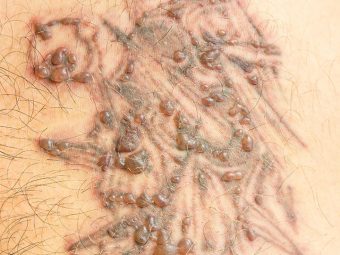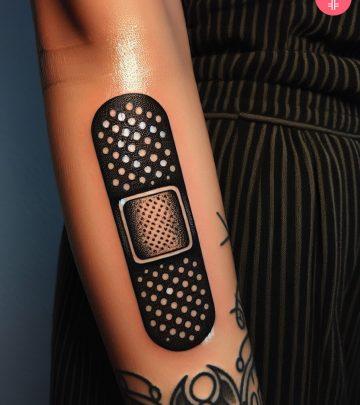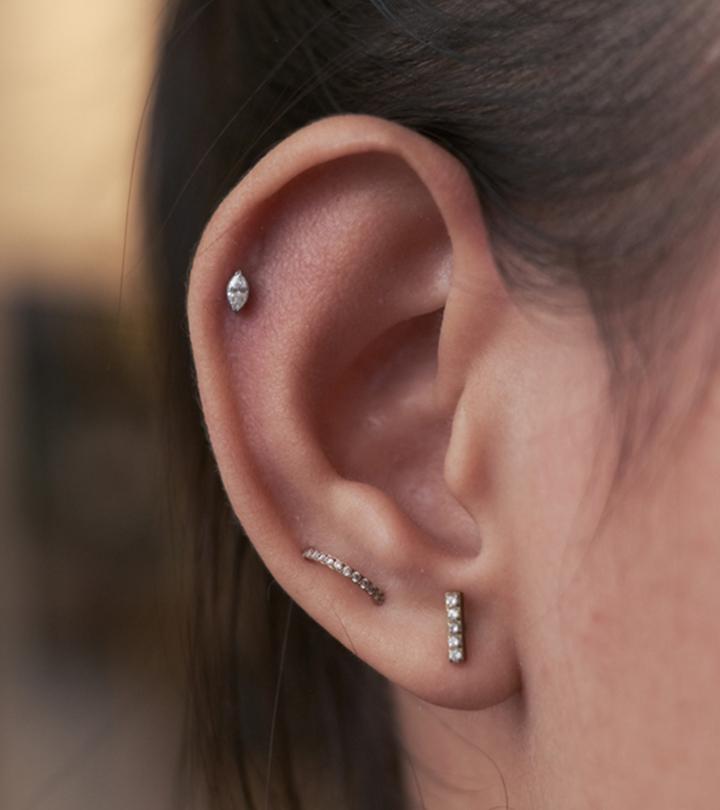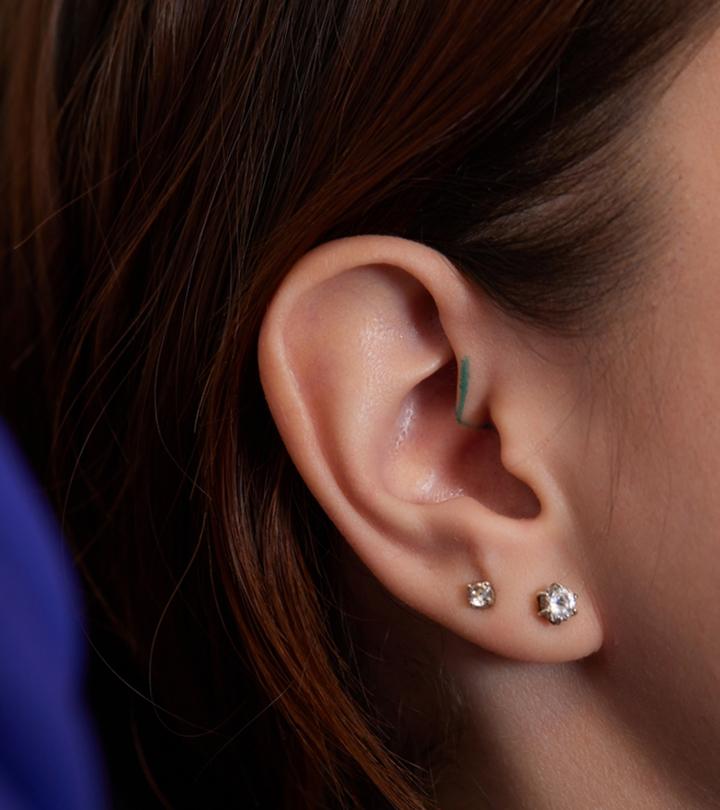Tattoo Ink Sack: Its Purpose And How To Get Rid Of It
Learn to deal with fluid buildup on your new ink.
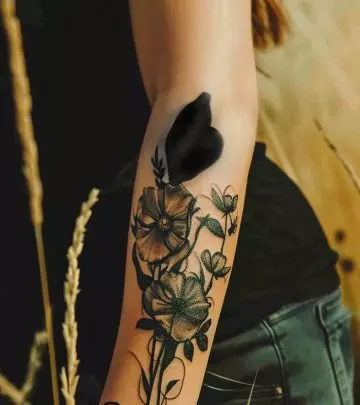
Image: Created with Midjourney
The occurrence of tattoo ink sacks on fresh tattoos is a common phenomenon. It is even considered a normal part of the healing process these days– something that was unheard of only a few years ago, when tattoos healed the same way as most superficial wounds, except with the addition of a pretty inked pattern. Since the tattoo healing process can be painful and uncomfortable, there have been multiple attempts to upgrade tattoo aftercare methods to make it convenient. Specialist tattoo bandages are relatively new aftercare products intended to ensure the same, but they come with trickier aftereffects, such as the formation of tattoo ink sacks, supposedly meant to aid in healing tattoos faster.
So what exactly is a tattoo ink sack? In this article, we shall explore what causes it, if it poses any health risks, how to get rid of it, and more. Keep reading to know more.
In This Article
What Is A Tattoo Ink Sack?
A tattoo ink sack, also called a “tattoo ink bladder” or “plasma sack” is a pocket of fluids that forms over a fresh and healing tattoo under its dressing. The fluid typically comprises a mix of leaked tattoo ink pigments, plasma fluid, and possibly blood. If there is no rejected ink mixed with these fluids, the tattoo ink sack may have a clear yellow or greenish-yellow tint, else it can mix with the colors of the pigment. Its size may vary depending on the size of the tattoo and it usually has an oval or round-ish bubble-like appearance that is not very pleasant to look at.
Let us understand how these tattoo ink sacks are formed.
What Causes A Tattoo Ink Sack?
After finishing the tattoo, most professional tattoo artists wrap the inked area with special bandages like Saniderm, clear adhesive bandages, or plastic tattoo bandages for the dressing. They are said to be the most advanced and effective tattoo healing methods currently available in the market. Such dressings have become the norm and you will find most tattoo parlors offering, even insisting, on using them. They form an efficiently protective film over the tattoo and are said to be more hygienic dressing options than kitchen cling film wraps or saran wraps that were traditionally used. These special tattoo bandages are waterproof and non-permeable so they do not allow air and bacteria in, nor do they allow tattoo fluids to leak out, in a bid to let tattoos heal uninterrupted.
Your tattoo artist may instruct you to keep these wraps on for 3-4 days for the protection of your tattoo. During this time, as your tattoo heals, it may leak any excessive tattoo pigments rejected by your skin and plasma lymphatic fluid. The plasma fluid is a portion of blood that contains blood proteins that have a number of important functions, blood clotting being one of them. It is this ink-stained plasma that builds up underneath the see-through dressing of your tattoo and forms the tattoo ink sack. It appears within the first 24 hours of wrapping your tattoo.
Although this fluid-filled pocket appears rather unhygienic, anecdotal claims suggest that it is a necessary step in healing. Let us find out more about this in the next section.
What Is The Purpose Of A Tattoo Ink Sack?
As the process of tattooing basically entails puncturing the top skin layers, it is a trauma-inducing process for the skin and it triggers the immune system to respond against it. As the wound heals, your body releases blood plasma which is an inflammatory fluid that protects the wound against potential risk of infection. So, this is a very normal healing process and most professionals will inform you about it as they dress your tattoo. But because this fluid cannot escape the adhesive dressing, it is trapped underneath, forming a stained and unsightly bubble covering the tattoo.
However, as the plasma remains in its fluid form, it prevents the tattoo from scabbing and supposedly allows a healthy healing environment. It also forms a layer between the tattooed skin and the adhesive lining of the bandage, not allowing it to stick to the wound. This ensures that the film dressing does not tug at your healing skin during its removal, potentially irritating it and causing more trauma.
Many tattoo professionals claim that after they apply moisturizing foam on their clients’ tattoos, they prefer wrapping it with special tattoo bandages like Saniderm, despite the tattoo ink sacks, because they:
- Promote faster sealing of the tattoo wound
- Lower the risk of contamination from bacteria, dust, etc.
- Protect the tattoo from the elements
- Prevent the excessive bleeding, leaking, or spilling of tattoo fluids and creating an inconvenient mess everywhere
- Prevent itchy scabbing of the tattoo while allowing it to breathe
Jenna, a lifestyle blogger, shares her experience using Saniderm for the first time, in one of her blog posts. “My first night with this on my leg was interesting. I am used to worrying about getting ink and plasma on my sheets, but when I awoke the next day, no mess at all (i),” she says. It took her tattoo 7 days to heal and the tattoo peeling stage lasted just one day, revealing a clear and crisp tattoo the next day. She also mentioned how she was so satisfied with this method that she would never go back to traditional healing options.
Now the buildup of a tattoo ink sack and the overall healing process may vary for different people depending on how big their tattoo is. But there is generally nothing to worry about as these bandages are usually medical-grade, and although they are non-permeable, they are designed to allow gases like oxygen to permeate the film. Hence, by all means, they are meant to ensure a convenient tattoo healing experience.
But still, it is quite natural to wonder if these tattoo ink sacks will distort your precious tattoo itself in any way. Scroll down to find the answer to this.
Will The Ink Sack Ruin My Tattoo?
No. The tattoo ink sack by itself will not ruin your actual tattoo or your skin. It is not known to pull out ink from the tattoo, nor does it let the skin get infected. On the contrary, it is known to be a great method of letting lymphatic fluid drain naturally from the tattoo wound without causing uncomfortable scabbing and lowering the risk of inflammation.
In some cases, it has been noted that tattoo ink sacks can temporarily alter the colors or vibrancy of your tattoo. However, the tattoo is said to regain its vibrancy or desired colors with the progression of the healing process.
Therefore, unless your body has an allergic reaction to the ink pigments or your skin gets triggered by the action of the tattoo needle piercing it, your tattoo is not at much risk of getting ruined.
While a tattoo ink sack is a natural reaction of the body’s immune response to tattooing, some people may experience a larger amount of plasma fluid buildup and may also find it painful. In such cases, it is best to contact your tattooist for advice or seek medical attention from a dermatologist.
A good tattoo aftercare regime is fundamental to the healing process, and it is best not to meddle with the ink sacks. Let us learn more about dealing with them in the following section.
Can You Pop A Tattoo Ink Sack?
No. Tattooists strictly advise against popping, scratching, or poking at the tattoo ink sacks as it can interfere with the tattoo’s healing and may potentially even lead to medical complications. Here are some important reasons why you must not pop a tattoo ink sack.
- Increased Risk Of Infection
Popping a tattoo ink sack exposes your fresh tattoo wound to an increased risk of infection. It allows the introduction of bacteria and dirt that can interrupt the healing process, damage the tattoo, and may even lead to symptoms of fever and chills if the infection progresses.
- Slow Healing Process
Since the tattoo ink sack is a natural healing process and popping it is interrupting the process, it can lead to a delayed healing timeframe. In fact, if there are infections, the priority shifts from healing to treatment of the tattoo infection, further adding to the healing timeline.
- Increased Chances Of Scarring
Popping the ink sack can be traumatic for your skin, therefore leading to skin damage and scarring. This can also impact the final appearance of your tattoo.
- Uneven Spreading Of Ink
Although the tattoo ink sack mostly contains rejected ink, it also keeps used ink trapped in the tattoo wound. Popping open an ink sack may force out the required ink, making the residue spread unevenly and damaging the overall aesthetic of your tattoo.
All that said, in certain cases depending on the way your body typically handles wound healing, a tattoo ink sack may get over-filled, develop a tiny rupture by itself, and start leaking the tattoo fluid. Not just that, this also means that your tattoo wound is now exposed and vulnerable to viral or bacterial contamination and infections. Therefore, it is important to keep checking your ink sack once every 24 hours.
If you notice the ink sack growing abnormally large, you might have to remove it. Scroll to the next section to learn how to do it safely.
How To Get Rid Of A Tattoo Ink Sack?
If you need to remove your tattoo ink sack, follow these steps for a safe and hygienic removal process:
- Begin from the top corners of your bandage and gently pull it downwards. Do not rip it off as you will burst the entire sack and even pull on any minor scabs. The sack and the scabs need to fall off on their own or you will risk infections or a prolonged healing process.
- Clean the tattoo area using lukewarm water and a mild soap (preferably an antibacterial soap). While doing this, you might notice some more leaking, which is fine, let it drain by itself. Do not submerge your tattoo in water as this will over-hydrate your wound, making it susceptible to bacterial infection. Simply pour the warm water gently over the area to remove the soap suds after cleaning. Then pat the area dry with a clean paper towel to soak up extra moisture as well as any more leakages.
- Apply a thin layer of the special tattoo ointment or moisturizer recommended by your tattooist. Do ask your tattooist beforehand for tattoo aftercare instructions and products that can be used within the first 24-48 hours after dressing the fresh tattoo, in case you might need to change the dressing.
- Reapply a new and clean tattoo dressing if you still have fluid in your ink sack. However, if your ink sack was already 3-4 days old and burst by itself, you need not dress it again, and let it dry and heal by itself. Do remember not to scratch or pick at any new tattoo scab.
So, this is how you can treat an abnormally growing tattoo ink sack. But as the common saying goes, prevention is better than cure. Therefore, let us see if there are any preventive measures one can take to begin with.
Can You Prevent Tattoo Ink Sacks From Forming?
It is not possible to prevent tattoo ink sacks from forming. As mentioned above, it is a natural reaction of your body and forms part of the natural healing process if you are using special tattoo bandages. If you use regular household plastic wrap for a day or two and then let your tattoo dry, then you may not develop an ink sack, but your tattoo will surely scab and get itchy. This exposed predicament will make it harder to control the urge to scratch it.
An ink sack may have an unsightly appearance but they are making sure your recovery is a smooth, comfortable, and convenient process as your body does its best to repair your skin barrier and keep adverse reactions at bay.
So, do not fret too much about it. Just make sure you follow your tattoo artist’s aftercare instructions diligently, keep your tattoo clean, and use top-quality tattoo care products. However, if you notice signs of infection such as unusual swelling, redness, pain, skin irritation, prolonged bleeding or healing, etc., do make it a point to talk to your tattooist for further guidance.
Tattoo ink sacks are a regular and natural part of the tattoo healing process these days. If you opt for the most advanced tattoo aftercare solutions, your tattooist will recommend the use of tattoo adhesive bandages that will inevitably lead to a tattoo ink sack. But this is not something to be worried about as it is meant to protect your tattoo from contamination and infections, prevent scabbing, and trap bleeding fluids, making the overall healing process convenient. It also does not let the bandage stick directly on your healing tattoo, therefore any potential skin irritation is minimized during the removal of the bandage. However, do keep in mind that if the fluid buildup is excessive, then the sack may start leaking and making the tattoo vulnerable to infections. In such a case, do gently remove the bandage. Subsequently, if you develop an infection, seek medical aid immediately.
Frequently Asked Questions
How long does an ink sack last?
The duration of an ink sack depends on its size and your body’s healing capacity. Small to medium-sized sacks can disappear within 1-2 weeks. However, larger sacks that appear on big-sized tattoos can even take up to 3 weeks.
Do tattoo ink sacks smell?
No, a tattoo ink sack is not supposed to smell as blood plasma is odorless and the adhesive film is mostly non-permeable. However, if the tattoo gets infected due to improper bandaging, or if fragranced ointments and lotions are used, then the ink sack might have a peculiar smell. Additionally, underlying skin conditions such as eczema or psoriasis may also cause a mild odor unrelated to the ink sack.
How do you clean a tattoo after the ink sack?
Use lukewarm water and mild, unscented, antibacterial soap to clean the tattoo, and pat dry with a soft, clean towel. Avoid causing any irritation to the tattooed area by scratching, harshly rubbing with the towel, or using loofahs and washcloths to wash the area. Apply a thin layer of moisturizer recommended by your tattooist.
Key Takeaways
- A tattoo ink sack is a fluid-filled pocket that forms over the tattoo when it is wrapped with a special tattoo adhesive. This fluid comprises rejected ink and blood plasma.
- As the immune system responds to the trauma from tattooing needles, it releases these inflammatory fluids and hence, this is a normal part of the healing process.
- The tattoo ink sack is a better alternative to other protective films as it protects the tattoo from contamination, prevents scabbing, and forms a layer between tattooed skin and the adhesive lining of the bandage. This ensures the tattoo can breathe and heal smoothly with minimized irritation to the skin.
- If a tattoo ink sack is overfilled, it may rupture by itself and start leaking. Hence, it must be checked every 24 hours and must be replaced manually, by employing gentle removal and cleaning methods.
If you are using a specialist tattoo bandage, the formation of a tattoo ink sack is inevitable. However, it is a natural process and goes away by itself with proper aftercare. Watch this video where a vlogger shares her day-by-day tattoo healing process using Saniderm.
Personal Experience: Source
StyleCraze's articles are interwoven with authentic personal narratives that provide depth and resonance to our content. Below are the sources of the personal accounts referenced in this article.
(i) My First Experience Healing With Sanidermhttps://jennafleshtats.wordpress.com/2016/02/06/my-first-experience-healing-with-saniderm/







